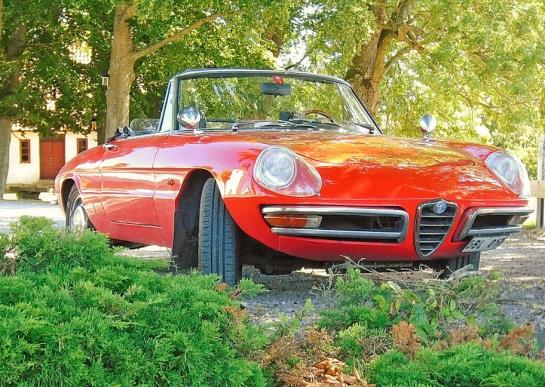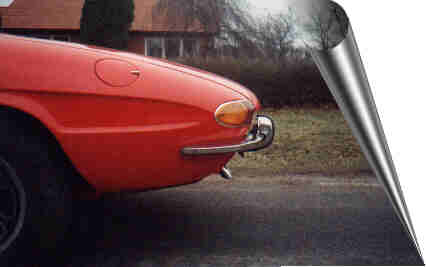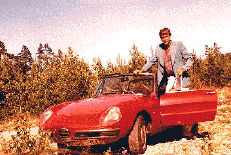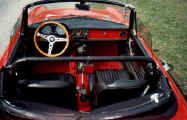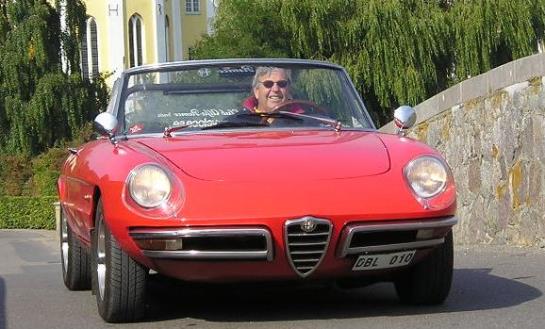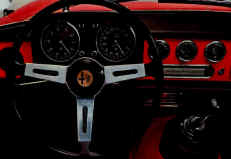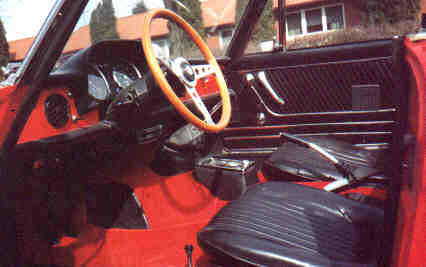|
My 1967 Spider Veloce is named Gina by me, because
she's an Italian beauty.
|
|
The best design ever.
The design of the rear end of the Spider is fascinating. In 1969 I finally got the chance to see a Duetto, a Spider Veloce. Until then I've had various Alfas but was so attracted to the Spider. During the summers in Italy I was constantly looking in the junkyards for spares. It strikes me, that I never saw any Duettos or Spider Veloces there. The owners obviously took well care of the cars. In early 1970 I finally bought a Duetto. My car was a 1967 Spider Veloce, the one with the 1750 engine. Rosso Farina AR514 of course. I named my car "Gina" since she was an Italian beauty.
I didn't know by then how rare my car was. In 1969 the authorities did enter a 1967 car as a 1969-year model even if the correct model year was 1967. They based the data when the car was sold. Strange.
I have found out that many Alfas have different year identification due to the date when they were registered. My Gina is one of the very first Spider Veloces. She left Arese on May 7th 1967. I have no idea of what she was doing until 1970. Anyway, I was very happy. Today I know more about the car. She has a single brake booster and the pedals are standing on the floor. It is very hard to tell from the outside if it's a Duetto or a Spider Veloce.
The engine was also one of the very first 1750's. I had the non-offset pistons, but I changed these to offset Borgos later. Read all about it in my mechanical page. Weber carburettors and the air-intake on the left side were also high-tech 1967. The left rear-wing mirror was on the panel on the early Spider, but in 1968 Alfa moved it to the door. It was definitely easier to adjust from the driver's seat there.
The interior is almost the same, but have a look at the ashtray. The Duetto has a smaller one than the Spider Veloce. The instruments are similar, made by Jaeger. Later they were equipped with Veglia Borletti. I have red carpets in my car, but these were optional. The standard interior included black rubber mats.
The original steering wheel on the Duetto was black and plastic. The first series Spider Veloce had a wooden wheel made by Hellebore. That wheel had three spokes and was very classic.
There were also three spokes for the horn but no such button in the centre. The original steering wheel was 14". The cars had no power steering in those days, so it might be heavy to drive at low speed.
Rather rather small switches on the
dashboard operated the fan, the wipers and the instrument
lights. I got used to the strange head light flash quickly,
but friends who drove my Spider, had a hard time. Pressing the
stick activates the head light flash. The normal procedure on
other cars was to pull the stick backwards instead. No problem
to me, though. While driving in the sun, the warning lights were hard to spot on the panel. Actually, when driving an Alfa your main concern are the enormous rev-counter and the oil-pressure, oh yes, the law might also to be considered. BTW, the oil pressure has a warning light as well as a regular instrument. Strange enough, the pressure was always 100 per cent normal on my Alfas. That is, when idling the needle was pointing at 11 o'clock and when revving the needle pointed at noon to 1 o'clock.
Anyway, it added a sporting touch to the Alfas. The instrumentation was not the same as Alfa used in the 1750 GTV. The oil pressure was separated from the rev-counter and positioned together with the temperature and fuel, just above the radio. On the GTV the oil pressure was integrated with the rev-counter. The Spider has fuel meter to the left, oil in the centre and temperature far right.
When buying a Spider, observe if all of the instruments are made by the same manufacturer. If not, they have been swapped. This may not always be a bad sign, but the mileage may not be true. Jaeger instruments were common on pre-1969 Spiders. The rev-counter and speedometer are not equal to the instruments of other Alfas. The rev-counter has no oil-pressure meter like in the GTV. The speedometer has only a warning light for the alternator and no such for the heating fan like the GTV has.
Veglia instruments are mainly used on the GTV and on Spiders after 1969. It's good to know, that the mileage is almost impossible to temper with on the cars. Steel and brass make a good instrument, not like plastic and junk in the '80s. Also note, that the speedometer was the same both in Duetto and Spider Veloce. The different speeds were true indicated by using different speedometer driven gears in the gearbox.
The Duetto had a final ratio of 4,55 and the Spider Veloce had a 4,1 ratio. Another strange thing was that the temperature was showing a hot engine with the ignition off. This is caused by the wiring and quite normal. Once the ignition is turned on, the instrument shows the accurate temperature.
The red warning light for low fuel is almost impossible to see. It is hidden in the fuel meter and only slightly visible in the night. Normally, that's no problem. Say if you're out driving with your date and run out of fuel. What do you do in the middle of nowhere in the dark?
Don't tell me, find out for yourself.
This is what you see inside my Spider. I installed the anti roll bar in 1972. I was not that keen on the original safety belts, so I replaced them with tree-point belts instead. The anti-roll bar is rather neat and does not disturb the Farina design. |
